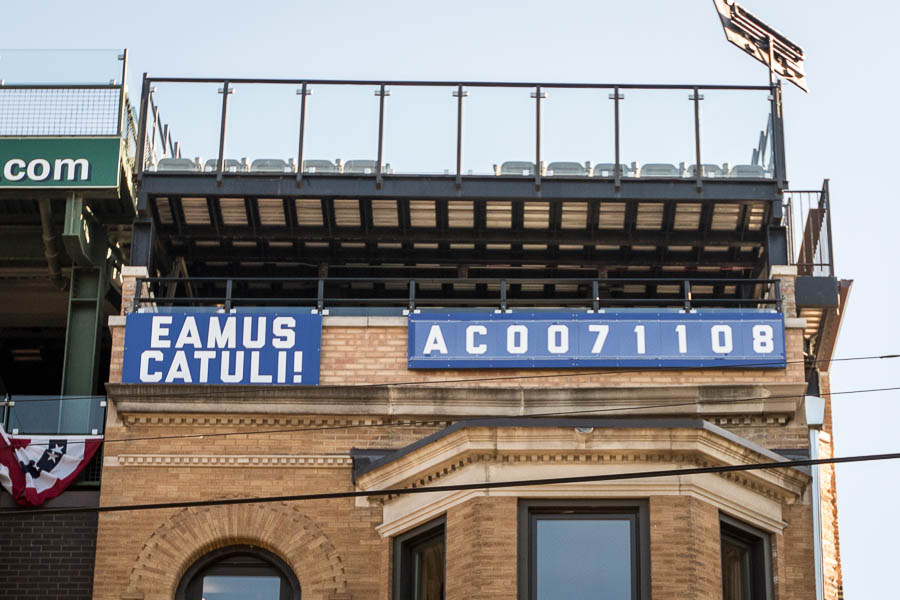Here's hoping for a Game 7.
The Cubs won last night's game so they get to play Game 6 tomorrow night in Cleveland. Whew!
Last night also set a few records:
- It was the latest Cubs home game ever (October 30th).
- It ended the longest period in Major League Baseball that a team went between World Series home-game wins (25,955 days).
- It set the record for highest attendance at Wrigley Field in a season (3,232,420).
The Cubs are still favored to win the series, but it'll be tough. I'll be watching.
All of these articles look interesting, and I hope I get to read them:
Oh, fun! Another meeting!
Until yesterday, 25,951 days had passed since the last time the Cubs won a game in the World Series. And tomorrow night, it will have been 25,951 days since the last time a World Series game has been played at Wrigley Field.
More than that, as of today, 39,460 days have passed since the last time the Cubs won the whole thing.
Let's keep that last number under 39,467, OK? Eamus Catuli!
It's only one game out of a best-of-seven series, but last night the Cubs did not look like the same team they've been all year. Some highlights:
Corey Kluber pitched neatly into the seventh inning, Roberto Perez hit two home runs and the Cleveland Indians beat the Chicago Cubs 6-0 tonight in the World Series opener.
In a matchup between the teams with baseball's longest championship droughts, the Indians scored twice in the first inning off October ace Jon Lester and were on their way.
7:15 p.m.
Dexter Fowler took a called third strike from Cleveland Indians ace Corey Kluber leading off the game, becoming the first Chicago Cubs player to bat in the World Series in 25,948 days.
Chicago had not played a Series game since Oct. 10, 1945, when Don Johnson hit into a game-ending forceout against Detroit's Hal Newhouser in Game 7.
8:10 p.m.
Indians ace Corey Kluber has set a World Series record with eight strikeouts through the first three innings. Cleveland leads the Chicago Cubs 2-0 in Game 1.
The eight strikeouts also represent the most by an Indians hurler in a World Series game.
It just got worse. They looked like the Cubs of old. I am not pleased.
This is not the way I'd hoped the World Series would open.
Update, bottom of the 8th: Really, really, really not the way.
The guys over at 538 have proved the Cubs really are the unluckiest team in baseball—but they still give them a 48% chance of winning the World Series:
[A]ny ballclub that appears in the postseason often enough — no matter how mediocre its teams are — should eventually be guaranteed a World Series win. But for more than a century’s worth of Cubs squads, no level of greatness has been able to get them over the hump. I determined just how unlucky each franchise has been over its postseason history by taking its Elo rating and the size of the playoff field and then calculating how likely the team was to win the Series each year using the process I outlined above. I added up those probabilities from all the years in which a World Series was held and compared them with how many titles the teams actually won, and I found that the Cubs are the unluckiest team of the last 113 years.
Just based on the pretty-good teams the Cubs have featured in their 18 playoff appearances, my model expected them to win six or seven championships. Instead, they’ve only won two since 1903, and both were more than 100 years ago. (Notably, this year’s Cubs triumphed in the NLCSover the second-most-unlucky team, the Los Angeles Dodgers.) The Cubs have had more years to be unlucky than most teams, since they’ve existed for a long time. But even on a per-playoff-season basis, the Cubs have been the least fortunate franchise in baseball.
That said, the Cubs are in Cleveland tonight to play their first World Series game in 71 years. Will they win it all? No one can say. But they're here.
It's really real:

Now all they need to do is update this sign:

Holy shit. They did it.
More later; still absorbing it.
Still busy. So busy.
And now I have to set up a development environment.